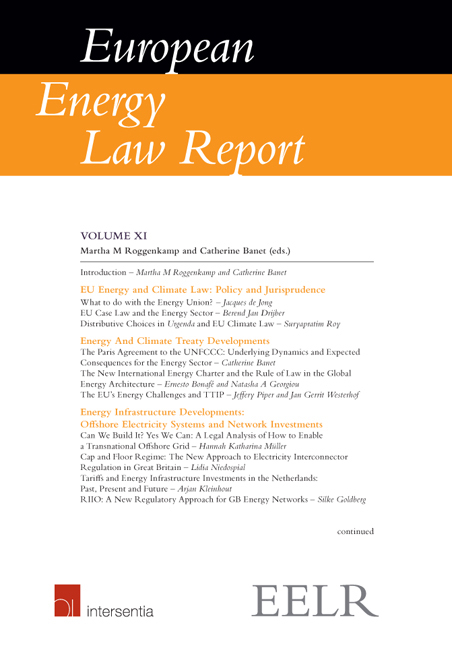Book contents
- Frontmatter
- Editorial
- Contents
- List of Abbreviations
- List of Contributors
- Introduction
- Part I EU Energy and Climate Law: Policy and Jurisprudence
- Part II Energy and Climate Treaty Developments
- Part III Energy Infrastructure Developments: Offshore Electricity Systems and Network Investments
- Part IV Heat Supply Legislation in the Eu
- Chapter XI District Heating Regulation in Sweden
- Chapter XII Heat Supply in Denmark: Any Lessons to Be Learned?
- Chapter XIII The Heat is On: Developments in the Regulation of the Heat Market in the Netherlands
- Part V Security of Energy Supply and Safety
Chapter XI - District Heating Regulation in Sweden
from Part IV - Heat Supply Legislation in the Eu
Published online by Cambridge University Press: 29 September 2018
- Frontmatter
- Editorial
- Contents
- List of Abbreviations
- List of Contributors
- Introduction
- Part I EU Energy and Climate Law: Policy and Jurisprudence
- Part II Energy and Climate Treaty Developments
- Part III Energy Infrastructure Developments: Offshore Electricity Systems and Network Investments
- Part IV Heat Supply Legislation in the Eu
- Chapter XI District Heating Regulation in Sweden
- Chapter XII Heat Supply in Denmark: Any Lessons to Be Learned?
- Chapter XIII The Heat is On: Developments in the Regulation of the Heat Market in the Netherlands
- Part V Security of Energy Supply and Safety
Summary
INTRODUCTION
The purpose of this chapter is to present the legal framework that applies to district heating in Sweden. We will assess how and in what way the main legislation on district heating in Sweden, the District Heating Act, takes into account the quasi-monopoly character of the market, and how and in what way it protects end consumers. In order to put the Act and its content into perspective, we will first provide an overview of the history of district heating and district heating regulation in Sweden, including a general introduction to the District Heating Act and the main players in the Swedish district heating market. Thereafter we will discuss in more detail two main elements that aim particularly at protecting the consumer, namely, the main content of a district heating contract and the regime of tariff regulation. The chapter will conclude with a brief analysis of the current regime.
DISTRICT HEATING IN SWEDEN
HISTORICAL BACKGROUND
The idea behind district heating in Sweden is simple. By primarily using inexpensive, locally available resources that would otherwise have gone to waste, local heating needs can be met in an efficient, financially and environmentally sustainable way. This is achieved by using waste heat from industries and by producing heat in installations such as biomass power plants (biokraftvärmeverk) and combined heat and power plants (CHP).
The story of district heating in Sweden is generally considered as a ‘success story’. Already in the late 1940s engineers employed by municipalities started to develop ideas and systems for a new collective heating system consisting of pipelines supplying heat to end customers. The ideas met widespread resistance from parties with vested interests such as oil companies, chimney sweepers and plumbing consultants who would lose jobs and market opportunities if this new heating concept were to be successful. However, such vested interests were unable to prevent the introduction of district heating. The first Swedish district heating system was constructed in 1948 in the municipality of Karlstad and soon after, in 1951, the cities of Malmö and Norrköping developed similar systems.
The success of district heating in Sweden can be explained inter alia by the Swedish tradition of cooperation, ie voluntary joint activities by a group of interested parties in order to meet a common goal. Already in 1949 the first cooperative association for district heating was founded, the organization ‘Värmeverksföreningen’ (or Heating Plant Association).
- Type
- Chapter
- Information
- European Energy Law Report XI , pp. 223 - 238Publisher: IntersentiaPrint publication year: 2017

